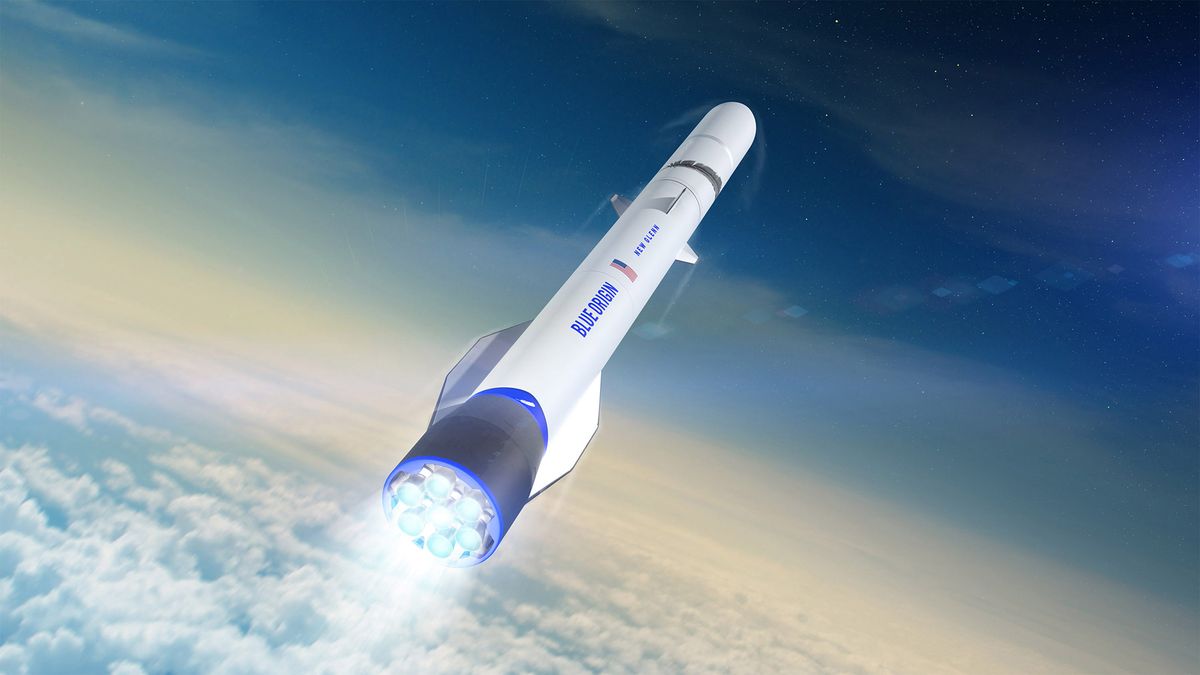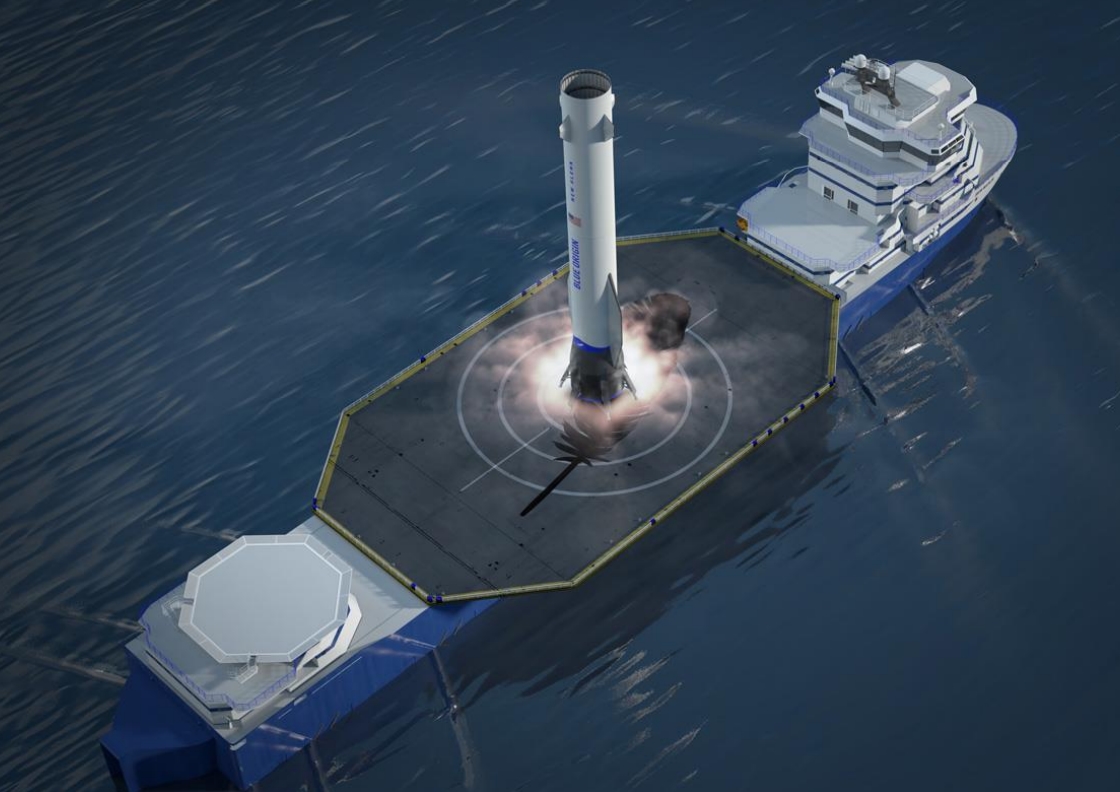
How New Glenn Plans To Land On A Moving Ship
Since first being announced in 2016, Blue Origin’s New Glenn has had a lot of negative attention. This has to do with many different factors including delays, Jeff Bezos, comparisons, and more. However, despite the not-so-positive attention, Blue Origin has continued to work on their next-generation heavy-lift launch vehicle. This rocket is meant to be the biggest ever made by Blue Origin and has some ambitious goals including landing the booster on a moving ship.
New Glenn’s booster first separates from the upper stage. Once separated it flies back towards Earth. Within the atmosphere, the booster will use a set of fins and strakes to fly and orient itself prior to landing. When the booster is close to the surface it will perform a final landing burn with one of the seven BE-4 engines and touch down on the moving ship.
This process has some similarities and differences to the Falcon 9 booster. Rather than a small drone ship Blue Origin is planning on using a large converted cargo ship. If successful, Blue Origin could have consistent access to an affordable and powerful launch vehicle. However, the company will need to master an extremely complicated task when trying to land the booster.
New Glenn Booster Specs

New Glenn is a heavy-lift launch vehicle under development by Blue Origin. This rocket is comprised of two stages and is meant to be fully reusable. At first, only the booster was meant to be reusable but recently Blue Origin has changed its goals and is working towards full reusability. New Glenn stands at 96m tall and 7m wide. This makes it the biggest rocket Blue Origin has ever developed by far. The first stage is 58m tall and will be equipped with 7 BE-4 engines.
These engines are also currently in development by Blue Origin. New Glenn is meant to become an efficient and competitive launch vehicle capable of taking crews and cargo into space and back. The estimated payload capacity to low earth orbit is around 45 tons. This is a large amount of weight and would help Blue Origin become a significant launch provider in the space industry. The company also has a very ambitious goal for the recovery of the booster and second stage. The booster is planned to be recovered on a moving ship. As for the second stage we are not quite sure just yet what the plan will be to safely land and reuse it.
How New Glenn Will Safely Land
Orient Itself – One of the first steps in New Glenn landing is the process of orienting itself towards the landing pad. New Glenn will not only have to be accurate but extremely precise. After stage separation, the booster will start falling back towards Earth. The New Glenn booster has 4 fins and 2 strakes. The 4 forward fins are positioned at the very top and the 2 strakes are at the bottom. These fins will be actuated aerodynamic control surfaces used for altitude adjustment during descent and landing. The 2 wing-like strakes will provide lift and cross-range as the booster flies back towards Earth. Blue Origin has said it’s expected that the booster will end up landing about 1000km downrange from the original launch location. The booster will need to perform every maneuver perfectly to ensure its right on target prior to a landing burn.
Slow Down – After New Glenn has pointed itself in the correct direction and is nearing the surface, it will need to slow down significantly. To do this Blue Origin is planning on performing a landing burn to remove the extra speed. In animations and graphics provided by Blue Origin, it only shows the booster doing a single landing burn right before touching down. This means that the one burn will have to be quite significant and produce a lot of power. The New Glenn booster has 7 BE-4 engines with a single engine in the center and six in a circle surrounding it. It is expected that New Glenn will only use the center engine for the landing burn. The first stage alone will generate almost 4 million pounds of force. This power will be necessary when a single engine is responsible for slowing the entire booster down for landing.
Landing Legs – With the New Glenn booster slowed down significantly and coming close to the surface it will need a secure way of landing. The booster will have 6 landing legs in total. These legs will be capable of folding and unfolding during launch. At liftoff and ascent, the legs will be folded in and flush with the booster. Prior to landing the legs will deploy and secure, ready to hold the weight of the booster. The 6 legs are hydraulically actuated and will need to be very big and sturdy to keep New Glenn steady after landing.
Ship Landing Pad – The final aspect of landing New Glenn’s booster is the landing pad itself. Blue Origin is planning on landing the booster on a moving ship. In 2018 Blue Origin bought a large cargo ship. Since purchasing the ship Blue Origin has been working to refit and modify the vessel into a future New Glenn landing pad. The ship is massive coming in at 183m long and almost 26m wide at the biggest spot. This large size is needed considering how big New Glenn is. Additionally, the large ship size will help keep it stable in many different weather and sea conditions. The ship will also be autonomously controlled ensuring that no one is hurt if the booster were to crash.
Ambitious Plans

New Glenn is a very ambitious plan from Blue Origin. The future plans of the launch vehicle bring up a lot of firsts for the company. This includes the large size of the rocket, full reusability, landing out at sea, landing on a moving ship, going to orbit, and much more. However, Blue Origin does have some experience and some additional positive aspects to consider. They have successfully landed New Shepard’s booster multiple times. While the New Glenn booster presents many more challenges it will still help in development and confidence.
The company also has access to a lot of funding through Jeff Bezos and different private investors. There will likely be a lot of failures prior to the first successful launch and landing but we will have to wait and see. It’s important to remember that whether you are a fan of Blue Origin or not, the success of their future projects such as New Glenn will heavily benefit the general space industry. Specifically, it will help increase access to space, lower launch costs, spark innovation, and more. If you are excited about the future space industry and what it has to offer then you can hope for the future success of Blue Origin.
Conclusion
The process of landing a massive booster on a moving ship is extremely complicated. There are many difficult steps throughout the landing maneuver that need to be executed perfectly for a successful landing. Some of these steps include orienting the booster, slowing down, deploying landing legs, and finally touching down on a moving ship. Blue Origin has a lot of work to do prior to the first successful landing. However, its ambitious goals like these that help innovate and improve the future of the space industry. We will have to wait and see how New Glenn’s development continues and if Blue Origin is capable of landing a booster on a moving ship.
